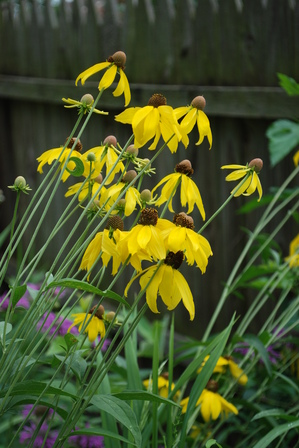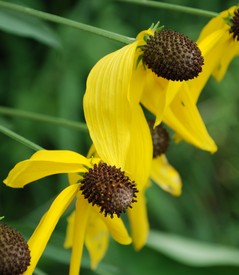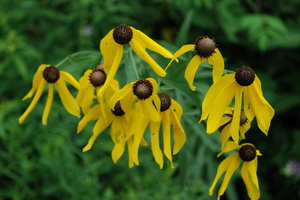
A cluster of coneflowers (Ratibida pinnata)
Rick Meader | Contributor
As you drive around the countryside, or visit natural or planted prairies or butterfly gardens, there is a very good chance you’ll encounter a relatively tall plant that is cheery in spite of its drooping character. It’s blooming now, and has striking, up to 3 inch-long lemon-yellow petals that fall away from the grey-brown conehead.Â
This plant is commonly known as grey-headed coneflower, yellow coneflower or pinnate prairie coneflower (Ratibida pinnata). Since it’s so commonly found in nature and in planted settings, I thought you might enjoy getting to know it more, up close and personal.
Grey-headed coneflower (known, in addition to the previously-given common names, as Drooping coneflower, grey-headed Mexican hat and even Weary Susan) is a member of the daisy (Asteraceae) family, as are the Rudbeckias, some asters and daisies. It blooms from July into August, and its nectar attracts butterflies and bees. The flowers are about 1-1/2 inches wide and have between five and 10 lemony-colored petals about 2 to 3 inches long that droop down toward the stem away from a central cone of disk flowers that begins grey-colored and becomes brown.Â
As the seeds mature, post-blooming, the seedheads gradually change in color back to grey. The mature seedheads are feasted upon by songbirds in late fall.

A coneflower closeup
Rick Meader | Contributor
This perennial is widely distributed across the eastern United States, from Vermont to Florida, and from the east coast west to Kansas, Oklahoma and Nebraska. It is naturally found in prairies, savannas and forest borders, and prefers rich, well-drained soil that ranges from dry to moist, with sunny to medium-sunny situations.Â
Apparently, it is a long-lived, strong plant, and may be one of the last survivors of prairies lost or plowed away long ago. Another factor that makes it a popular plant in prairie restoration seed mixes is it is among the more affordable of the forbs, so you can put a lot of color in your planting without breaking the budget. As a plant, it’s not terribly bulky, but its color makes up for its lack of girth. It has lanceolate, thinly-lobed leaves and the plant reaches a height of up to 4 feet tall.Â
In the “huh, I didn’t know that” category, there are some other fun features of this plant. For one, its roots may reach from 18 inches to 5 feet deep - truly beneficial features for rain gardens, and for stabilizing slopes as well. A feature of it that I particularly enjoy is the scent of the dried seedhead when you crush it. The accounts I’ve read describe it as a strongly anise scent, but I think it’s much more of a citrus scent, which is fun to smell on a snowy walk through a meadow.Â
It’s also fun to crush the seedheads, as they just kind of crumble away when they’re truly mature and dried. Native Americans used the root to cure toothaches, and they used the flower cones and leaves to make a tea. Early pioneers would use the dried seedheads like cedar chips to protect their clothing in storage.

An on-coming coneflower collision
Rick Meader | Contributor
It’s a great plant, and one you’re bound to see around town.
Blooming in my yard this week are: Yellow-headed coneflower, black-eyed Susan, brown-eyed Susan, nodding wild onion, woodland tick trefoil, marsh blazing star, Culver’s root, bugbane, wild bergamot, white snakeroot and big bluestem grass.
Have a great week, and enjoy nature everyone!
Rick is a local landscape architect with a special interest in all things natural, including native plants and the critters that eat them. You can contact him at yourland1824@gmail.com.





Comments
Rick Meader
Fri, Jul 30, 2010 : 12:20 p.m.
Thanks for your comments,everyone. First, Rork is right, as usual. Purple coneflower is not native to this area of Michigan. It is found in southwest Michigan, and states south and west of there. I did have the pleasure once of seeing a plant sample collected by Douglass Houghton in the Richland Prairie, which was between Kalamazoo and Battle Creek. The sample is in the University of Michigan Herbarium. It has become widespread due to people liking it and planting it in their gardens. If you want to do a true prairie restoration around here, you shouldn't include it in your plant mix. As for obtaining seeds for Ratibida pinnata, you could do as Rork suggests and gather a few seed heads from public plantings, but don't trespass to get them, and don't take much - it's important to leave a lot for reseeding the area. If you want to buy them, you can get local genotype seeds from Michigan Wildflower Farm (Portland, MI) or Nativescape (Manchester, MI), or get local genotype plants from Native Plant Nursery (Ann Arbor, MI) or Wildtype Nursery (Mason, MI). All of these suppliers have websites, so check them out! Finally, I forgot to include tall coreopsis on my bloom list, and I was thrilled to find 3 monarch caterpillars munching on my milkweed after 6 years of trying to get some to call my yard their nursery. Thanks for your comments! Rick
Rork Kuick
Wed, Jul 28, 2010 : 9:34 a.m.
The purple cone flower you see most in people's yards around here is Echinacea purpurea, and there are some other species in that genus that you might see more rarely. All 4 are native to places sort-of near here, but I've never seen any in the wild in our county yet. Inject "purple cone flower" into a search. I hate to say it, but a common method of obtaining seed for grey-headed (or other Compositae) is to find a place with thousands (not just a hundred) of plants, and take the seeds off of two or three flower heads. Or ask someone who has plenty - they will likely be quite happy to let you have seeds, since it makes so many. It's pretty common to see grey-headed as part of prairie plantings in parks or on road-sides. I won't name any particular places (psst, Huron river drive, north of the river, if I recall correctly - it's likely too early right now).
Jackie Byars
Tue, Jul 27, 2010 : 3:39 p.m.
I've also got lots of tall coreopsis and prairie dock blooming now.
81wolverine
Tue, Jul 27, 2010 : 3:30 p.m.
I've seen some of the grey-headed coneflowers around - very pretty. But, purple coneflowers seem to be a lot more common. Are the purples considered native or non-native? Also, can the grey-headed coneflowers be purchased easily in seed form?